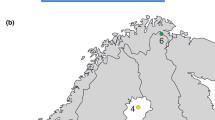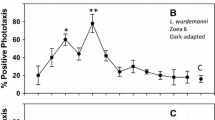Abstract
The visual ecology of fishes places changing demands on their visual system during development. Study of changes in the eye can suggest possible changes in behavioral ecology. The spectral transmission of the pre-retinal ocular media controls the wavelength of light that reaches the retina and is a simply measured indication of their potential visual capabilities. Dascyllus albisella is a coral reef planktivore known to have UV-sensitive retinal cone cells. UV vision probably aids in detection of zooplankton. As a juvenile it is very closely associated with branching coral heads or, more rarely, sea anemones. As it matures, it ventures farther from its coral, above the reef, and eventually assumes a more vagile life style, moving farther and more frequently afield. Their eyes contain short-wavelength blocking compounds in the lens, cornea and humors. As they age, both the lens and the cornea accumulate blocking compounds that increase the 50% transmission cutoff of the whole eye from ca. 330 nm in 2–3 cm juveniles to ca. 360 nm in the largest adults. The cornea increases its cutoff wavelength faster than the lens and becomes the primary filter in large adults. The cutoff of the aqueous and vitreous humors combined does not change with size. The slope of the transmission cutoff curve increases with the size of the fish. The increased blocking of UV radiation is likely not an adaptation to protect the eye from short-wavelength induced damage. Instead it probably reduces the image degradation effects of short-wavelength light in the largest eyes and still allows sufficient penetration of UV radiation to permit functional UV vision.
Similar content being viewed by others
References cited
Beaudet, L., I. Novales-Flamarique & C.W. Hawryshyn. 1997. Cone photoreceptor topography in the retina of sexually mature Pacific salmonid fishes. J. Comp. Neurol. 383: 49–59.
Bowmaker, J.K. & Y.W. Kunz. 1987. Ultraviolet receptors, tetrachromatic colour vision and retinal mosaics in the brown trout (Salmo trutta): age-dependent changes. Vision Research 27: 2101–2108.
Browman, H.I., I. Novales-Flamarique & C.W. Hawryshyn. 1994. Ultraviolet photoreception contributes to prey search behaviour in two species of zooplanktivorous fishes. J. Exp. Biol. 186: 187–198.
Collier, R. & S. Zigman. 1987. The grey squirrel lens protects the retina from near-UV radiation damage. pp. 571–585. In: J. Hollyfield (ed.) Degenerative Retinal Disorders Clinical and Laboratory Investigations, Liss, New York.
Danilowicz, B. 1996. Choice of coral species by naïve and fieldcaught damselfish. Copeia 1996: 735–739.
Douglas, R.H. 1989. The spectral transmission of the lens and cornea of the brown trout (Salmo trutta) and goldfish (Carassius auratus)-effect of age and implications for ultraviolet vision. Vision Research 29: 861–869.
Douglas, R.H. & C.W. Hawryshyn. 1990. Behavioral studies of fish vision: an analysis of visual capabilities. pp. 1–43. In: R.H. Douglas & M. Djamgoz (ed.) The Visual System of Fish, Chapman & Hall, New York.
Douglas, R.H. & N.J. Marshall. 1999. A review of vertebrate and invertebrate ocular filters. pp. 95–162. In: S.N. Archer, M.B.A. Djamgoz, E.R. Loew, J.C. Partridge & S. Vallerga (ed.) Adaptive Mechanisms in the Ecology of Vision, Kluwer Academic Publishers, Dordrecht.
Douglas, R.H. & C.M. McGuigan. 1989. The spectral transmission of freshwater teleost ocular media-an interspecific comparison and a guide to potential ultraviolet sensitivity. Vision Research 29: 871–879.
Douglas, R.H. & A. Thorpe. 1992. Short-wave absorbing pigments in the ocular lenses of deep-sea teleosts. J. Mar. Biol. Assoc. UK 72: 93–112.
Dunlap, W.C., D. McB. Williams, B. E. Chalker & A. T. Banaszak. 1989. Biochemical photoadaptation in vision: UV-absorbing pigments in fish eye tissues. Comp. Biochem. Physiol. 93B: 601–607.
Fite, K.V., A. Blaustein, L. Bengston & H. E. Hewitt. 1998. Evidence of retinal light damage in Rana cascadae: a declining amphibian species. Copeia 1998: 906–914.
Giese, A.C. 1976. Living with the sun's ultraviolet rays, Plenum Press, New York. 185 pp.
Hobson, E.S. 1972. Activity of Hawaiian reef fishes during the evening and morning transitions between daylight and darkness. U. S. Fish. Bull. 70: 715–740.
Hobson, E.S. 1974. Feeding relationships of teleostean fishes on coral reefs in Kona, Hawaii. U. S. Fish. Bull. 72: 915–1031.
Hogan, M.J., J.A. Alvarado & J.E. Weddell. 1971. Histology of the human eye. W.B. Saunders. Philadelphia. 687 pp.
Lobel, P.S. & D.A. Mann. 1995. Spawning sounds of the damselfish, Dascyllus albisella, (Pomacentridae), and relationship to male size. Bioacoustics 6: 187–198.
Loew, E.R., F.A. McAlary & W.N. McFarland. 1996. Ultraviolet sensitivity in the larvae of two species of marine atherinid fishes. pp. 195–209. In: P.H. Lenz, D.K. Hartline, J.E. Purcell & D.L. Macmillan (ed.) Zooplankton Sensory Ecology & Physiology, Gordon & Breach, Sydney.
Loew, E.R. & W.N. McFarland. 1990. The underwater visual environment. pp. 1–43. In: R.H. Douglas & M. Djamgoz (ed.) The Visual System of Fish, Chapman & Hall, New York.
Loew, E.R., W.N. McFarland, E. Mills & D. Hunter. 1993. Achromatic action spectrum for planktonic predation by juvenile yellow perch, Perca flavescens. Can. J. Zool. 71: 384–386.
Losey, G.S., T.W. Cronin, T.H. Goldsmith, D. Hyde, N.J. Marshall & W.N. McFarland. 1999. The UV visual world of fishes: a review. J. Fish Biol. 54: 921–943.
Lythgoe, J.N. 1979. The ecology of vision. Clarendon Press, Oxford. 244 pp.
Mason, D.S., F. Schafer, J.M. Shick. & W.C. Dunlap. 1998. Ultraviolet radiation-absorbing mycosporine-like amino acids (MAAs) are acquired from their diet by the medaka fish (Oryzias latipes) but not by SKH-1 hairless mice. Comp. Biochem. Physiol. A 120: 587–598.
McFall-Ngai, M., F. Crescitelli, J. Childress & J. Horwitz. 1986. Patterns of pigmentation in the eye lens of the deep-sea hatchetfish Argyropelecus affinis, Graman. J. Comp. Physiol. A 159: 791–800.
McFarland, W.N. 1986. Light in the sea-correlations with behaviours of fishes and invertebrates. Amer. Zool. 26: 389–401.
Novales-Flamarique, I., A. Hendry & C.W. Hawryshyn. 1992. The photic environment of a salmonid nursery lake. J. Exp. Biol. 169: 121–141.
Posner, D.M. 1998. Mycosporine-like amino acids in the fish ocular lens: biochemistry, evolution, ecology and function. Ph.D. Dissertation, University of Southern California, Los Angeles. 159 pp.
Randall, H.A. & G.R. Allen. 1977. A revision of the damselfish genus Dascyllus (Pomacentridae) with the description of a new species. Records of the Australian Museum 31: 349–385.
Rodriques, M.M., G.O. Waring III, J. Hackett & P. Donohoo. 1982. Cornea. p. 182. In: F.A. Jakobiec (ed.) Ocular Anatomy, Embryology and Teratology, Harper & Row, Philadelphia.
Smith, R.C. & K.S. Baker. 1979. Penetration of UV-B and biologically effective dose-rates in natural waters. Photochemistry & Photobiology 29: 311–323.
Thorpe, A. & R.H. Douglas. 1993. Spectral transmission and short-wave absorbing pigments in the fish lens-II. Effects of age. Vision Research 33: 301–307.
Thorpe, A., R.H. Douglas & R.J.W. Truscott. 1993. Spectral transmission and short-wave absorbing pigments in the fish lens-I. Phylogenetic distribution and identity. Vision Research 33: 289–300.
Thorpe, A., R.J.W. Truscott & R.H. Douglas. 1992. Kynurenine identified as the lens pigment in the deep-sea fish Stylephorus chordatus. Exper. Eye Res. 55: 53–57.
Walls, G.L. & H.D. Judd. 1933. The intraocular colour filters of vertebrates. British J. Ophthalmology 17: 641–675.
Whitmore, A.V. & J.K. Bowmaker. 1989. Seasonal variation in cone sensitivity and short-wave absorbing visual pigments in the rudd Scardinius erythrophthalmus. J. Comp. Physiol A166: 103–115.
Yu, N.T., M.Z. Cai, B.S. Lee, J.F.R. Kuck, M. McFall-Ngai & J. Horwitz. 1991. Resonance raman detection of a carotenoid in the lens of the deep-sea hatchetfish. Exper. Eye Res. 52: 475–479.
Zar, J.H. 1996. Biostatistical analysis. Prentice Hall, Upper Saddle River. 662 pp.
Zigman, S. 1995. Environmental near-UV radiation and cataracts. Optom. Vision Sci.: 899–901.
Author information
Authors and Affiliations
Rights and permissions
About this article
Cite this article
Losey, G.S., Nelson, P.A. & Zamzow, J.P. Ontogeny of Spectral Transmission in the Eye of the Tropical Damselfish, Dascyllus albisella (Pomacentridae), and Possible Effects on UV Vision. Environmental Biology of Fishes 59, 21–28 (2000). https://doi.org/10.1023/A:1007643800508
Issue Date:
DOI: https://doi.org/10.1023/A:1007643800508




